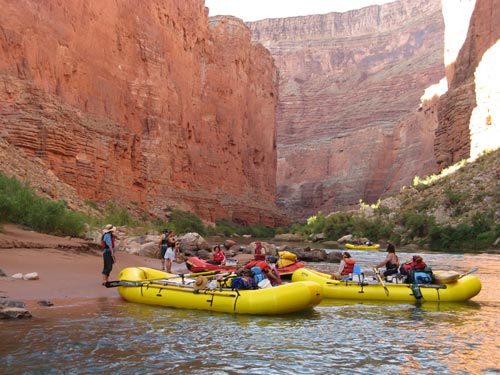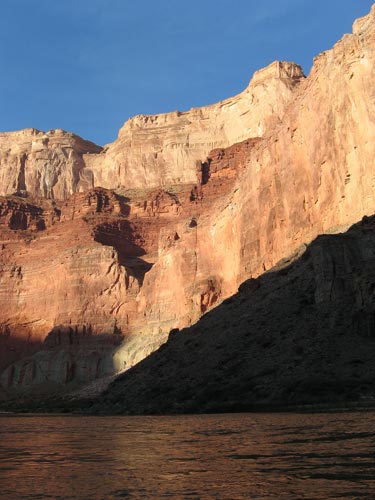- Buck Farm Canyon (mile 41) to Nankoweap (mile 53) -
We were up at 5 am. The river had risen drastically overnight. Water released from Glen Canyon Dam causes tides on the Colorado River. The dam lets out more water during the day than at night, since it can sell its electricity at a higher price during the day. Rafters who are unaware of the changing water level can sometimes get stranded on the beach overnight along certain parts of the river.

Preparing to leave Lower Buck Farm camp

Pulling out during high tide. River levels can fluctuate as much as three feet overnight.
After breakfast, we are back on the river.

Drifting through the canyon


President Harding Rapid (mile 43.7) is a 4 on the rapids scale with a 4-foot drop. In 1923, a U.S. Geological Survey Expedition stopped here when they received a radio message of the president's death and named the rapid in his honor.

While this may look quite peaceful, the buzzing sound of cicadas can get rather loud.


Many minor rapids never even get a name.
Around 1 pm, we arrived at Nankoweap Canyon, where were going to camp and then spend the following day.
More than 2,000 Ancestral Puebloan ruins have been found at the Grand Canyon. Modern descendants of these ancient people (including the Hopi) prefer the term Ancestral Puebloan instead of Anasazi, since Anasazi in Navajo means "ancient enemy." This culture probably first emerged around 1200 B.C. They are best-known for their adobe dwellings built along cliff walls, such as at Mesa Verde. Granaries were built to store and preserve food. As agriculture became more important, granaries served as a central location around which communities developed. It is not clear why the Ancestral Puebloans suddenly left their homes in the 12th and 13th centuries although ome suggestions include severe drought, climate change (resulting in agricultural failures) and hostility from new arrivals (war).

The granaries are located high in the cliff wall near Nankoweap Canyon.

They date back to the year 1100. Their tight construction protected food from rodents and preserved corn and seeds for long periods in a dry climate.

Pulling up to Nankoweap camp

Preparing lunch

Relaxing in the shade

The heat was a daily force to reckon with. As soon as the sun entered the canyon in the morning, the temperature soared to sweltering degrees. At night, the rocks and sand released the heat they had gathered during the day, causing gusts of warm air across the beach.
On two different occasions, cans of soda exploded from the heat... and they were in the shade (not in the direct sun) on the boats on the cool river (not on the hot beach).

Shadows creep into the canyon as evening approaches.
return • continue

